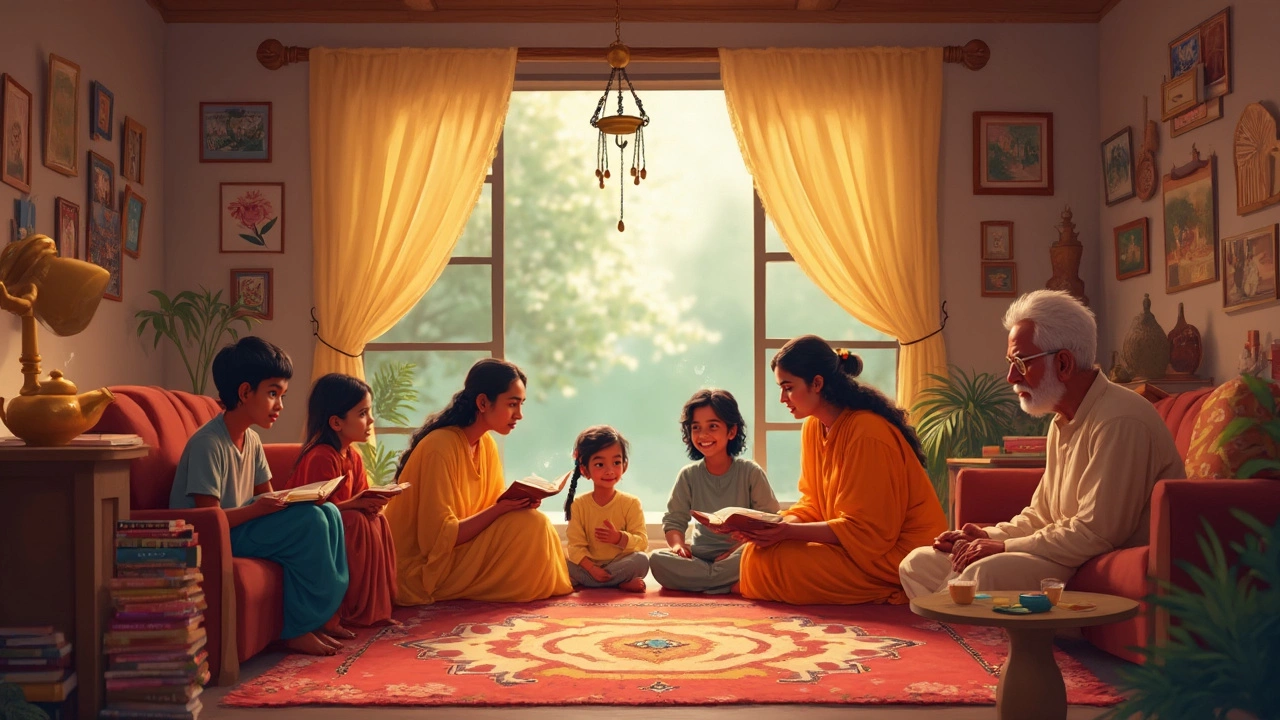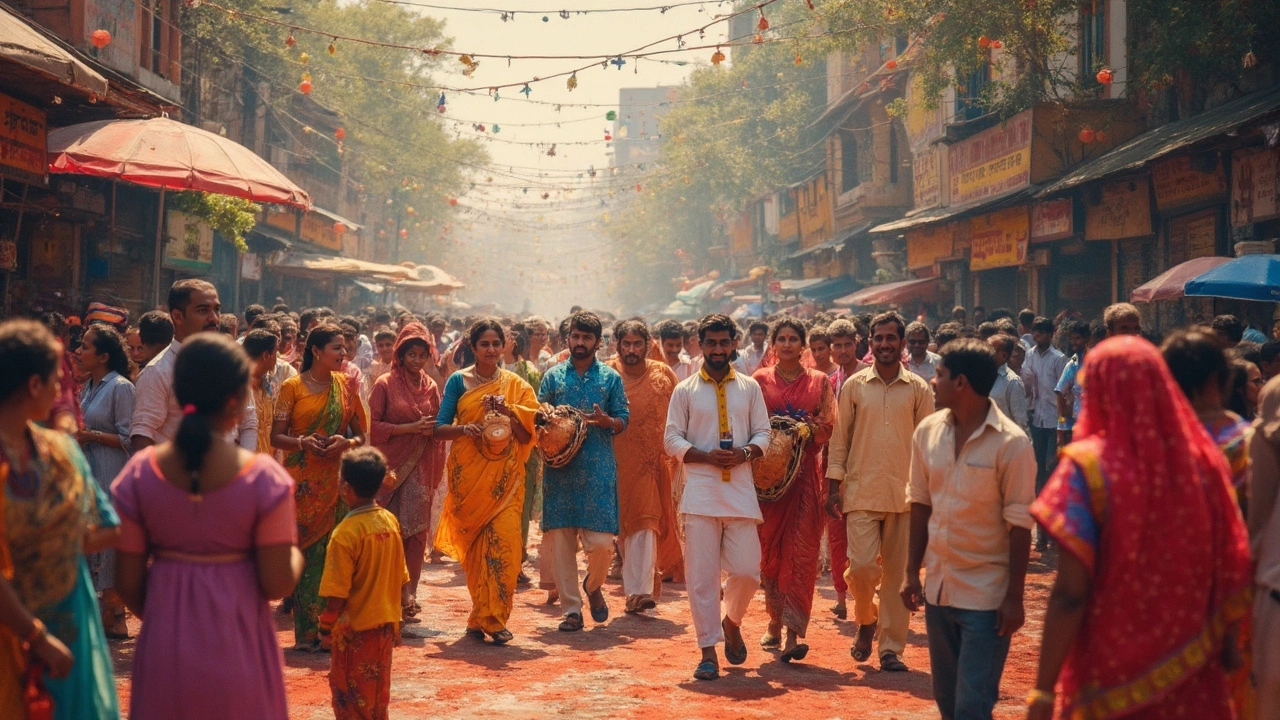Imagine standing in a place where people are making music with ancient instruments, sari-clad women paint bright designs outside their doors, and the aroma of spices makes you feel dizzy in the best way possible. That’s India—chaotic, dazzling, and deeply layered. It’s not just one country, but hundreds of micro-cultures doing a complicated dance together. You don’t need to travel far to see a celebration; you just step outside, and the world feels alive.
Layers of Diversity: Languages, Religions, and Communities
India’s diversity is not an empty slogan, it’s in your face everywhere you look. With 28 states and 8 union territories, and more than 1.4 billion people, India is a massive mix of colors, sounds, and beliefs. Do you know there are over 19,500 languages and dialects spoken in the country? The government recognizes 22 of those as official languages, with Hindi and English being the most widely used. Imagine riding a train from New Delhi to Chennai—the language on the platform, the look of the sari, and even the food in your thali changes every few hours. It’s wild.
Religion is everywhere, and sometimes it feels like a festival calendar that never ends. Hinduism is the largest followed by Islam, Christianity, Sikhism, Buddhism, Jainism, and a handful of smaller faiths with their own rituals. Cities like Varanasi have been places of worship for millennia. The city’s Ghats are filled with people bathing, meditating, and lighting lamps at sunrise. Sikhs in Punjab serve free meals, called Langar, to anyone who walks in, no matter what your beliefs are. And if you land in Goa during Christmas, you might think you’re somewhere in Europe. That’s the magic of Indian diversity—it’s always welcoming, sometimes a little overwhelming, and never boring.
Castes, tribes, and communities form more layers. Over 700 tribal groups add their own languages, art, and stories. Many still live close to nature with hunting, gathering, or farming as their way of life. The northeast is another world altogether, where bamboo houses and meat-heavy dishes replace the curries you get in Mumbai. It’s not just the past—modern India is wired and fast-paced, thanks to massive cities like Bengaluru, which mix ancient traditions with gleaming tech parks. Walk into an Indian home during a festival: grandmothers might be chanting Sanskrit prayers, kids texting on their phones, and teens blending Bollywood beats with K-pop. That’s harmony, Indian-style.

Traditions and Celebrations: From Diwali Lights to Holi Colors
If there’s one thing that unites India, it’s the love for celebration. Forget your usual dinner party—Indians stage weddings that can last five days and involve hundreds of guests (sometimes thousands). The ‘big fat Indian wedding’ is packed with music, endless food, rituals, laughter, and some seriously wild dancing. And everyone’s invited—yes, even your neighbors’ cousin’s friend.
Festivals in India are jaw-dropping. Each community has its own, but there are a few that have become national icons. Diwali, the festival of lights, sees people hang oil lamps and burst fireworks—symbolizing the victory of light over darkness. In 2023 alone, India bought over 800 million diyas (little clay lamps) for Diwali. That’s almost one for every adult in the country.
Holi, the color festival, is one messy, happy, wild ride. People throw colored powders and water, and no one cares if you’re a stranger. Just show up with old clothes and you’ll leave looking like a human rainbow. There’s more—Eid with its feasts, Christmas with midnight masses, Baisakhi harvest parties in Punjab, Onam flower carpets in Kerala, and Durga Puja’s giant clay statues in Bengal. Each state does it with its own flavor—literally, when it comes to food. During Pongal in Tamil Nadu, families cook sweet rice to thank the sun. In Rajasthan, you’ll spot camels parading through the desert during the Pushkar fair.
Indian art and music traditions are as lively as its festivals. Classical dances like Bharatanatyam, Kathak, and Odissi tell old stories with intricate moves and expressive faces. Bollywood might dominate Indian music today, but don’t miss out on the soulful melodies of Carnatic or Hindustani music. Instruments like the sitar, tabla, and flute shape a sound you won’t hear anywhere else. Visiting a live recital or open-air folk performance is like time travel—you’ll find yourself clapping along before you know what’s happening.
Cultural richness of India shines bright in everyday life, too—henna tattoos, rangoli floor art, family recipes passed down for generations, and even the way people greet each other (namaste, vanakkam, sat sri akal—pick one, you’ll always get a smile).

Hidden Heritage: Monuments, Crafts, and Daily Life
India is ancient. The country’s history goes back at least 5,000 years to the Indus Valley Civilization. Take monuments: more than 40 UNESCO World Heritage sites dot the land. The Taj Mahal isn’t just a pretty photo spot—it’s a monument to love that took 22 years and over 20,000 workers to build. But step off the tourist trail and you’ll find temples carved from a single rock in Ellora, the clay houses of Bishnupur, or forts that seem to rise right out of the desert in Rajasthan.
Handicrafts and textiles are at the heart of daily life. Each region is fiercely proud of its art. Banarasi saris twinkle with gold and silver, Kutch embroidery tells stories thread by thread, and Kashmir’s papier-mâché boxes are decorated with hand-painted flowers. There are over 3,000 craft clusters employing up to 7 million people. For example, Pochampally in Telangana is famous for its ikat weaving—a process so precise it can take months for one sari. You’re not buying just fabric; you’re buying the story behind it, the skill honed for generations, and the pride of a small community.
The food? Don’t even start unless you’re hungry. Every state has its own must-try dishes, shaped by geography and climate. In Kerala, coconut and spices shape almost everything; in Punjab, it’s about rich gravies and butter. Bengal is known for sweets like rasgulla, while Gujarat’s snacks always hit that perfect sweet-salty note. Street food binds India together—chaat stalls, samosas, and spicy curries are everywhere. Mumbai’s vada pav is the king of fast food; Delhi has its own chaat corners; Hyderabad is biryani paradise.
India’s hidden treasures hide in the ordinary too. The morning call of a vegetable vendor, train journeys where strangers become friends over chai, families gathering for cricket matches in the middle of a crowded lane—it’s all part of the fabric. People blend new ideas with old values, whether it’s celebrating International Yoga Day (yoga originated here over 2,000 years ago) or turning ancient stepwells into Instagram spots.
Want a sense of just how much India packs into a single day? Here’s a table comparing four states with quick facts:
| State | Main Language | Famous Festival | Signature Dish | Iconic Craft |
|---|---|---|---|---|
| Punjab | Punjabi | Baisakhi | Butter Chicken | Phulkari Embroidery |
| Kerala | Malayalam | Onam | Sadya | Coir Products |
| West Bengal | Bengali | Durga Puja | Fish Curry | Terracotta Art |
| Gujarat | Gujarati | Navratri | Dhokla | Bandhani Textiles |
So, if you’re curious, try a new recipe, visit a local Indian market, or join a community celebration. India’s stories are everywhere—you just have to listen, taste, and maybe get a little bit of color on your shirt.
